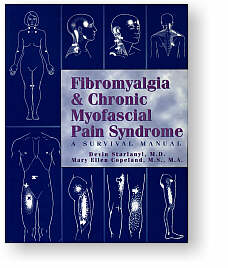| Info |
|
Fibromyalgia (fie-bro-my-al-jia) Syndrome

Fibromyalgia is an often misunderstood and misdiagnosed chronic condition. However, it must be understood that FM is *not* a "wastebasket" diagnosis. It is a syndrome which has a specific set of signs and symptoms that occur together. Although not technically listed as a disease due to it's lack of known causes it can be every bit as serious and disabling other various forms of arthritis such as Rheumatoid arthritis, or Lupus, or other afflictions classified as syndromes.
The key complaint with FM is pain described as a constant ache, nag or throbbing. Certain areas may cause sharp, stabbing pain. Typical pain locations include the head, neck, shoulders (especially between the shoulder blades), low back and hip muscles. Areas to the exact location of the pain can often be pointed out. Note that these particular areas are very sensitive to touch.
The official definition of FM states one must have at least 11 of the 18 tender points to be diagnosed. These tender points are painful when pressed but do not radiate pain elsewhere. Also, they must be found in all four bodily quadrants: upper and lower right, upper and lower left. In addition, widespread pain for at least three months must also be present.
The muscles are not the only sore areas. Other soft tissues, such as the ligaments, tendons and bursa, can be sore. Bursitis and tendinitis, especially in the shoulder, elbow and hip, are common in patients with fibromyalgia Another common area of pain is in the sternum, or breast plate, where the ribs attach. This is called costochondritis and can mimic heart pain, but there is nothing wrong with the heart.
In addition, there are various symptoms which also accompany FM aside from pain. They very from person to person in their presence and severity. FM itself may also be accompanied by several *other* conditions which require their own set of care...
Symptoms of Fibromyalgia:
Muscle pain -- Poor Sleep -- Fatigue -- Cold Intolerance -- Stiffness -- Headaches-- Numbness -- Joint Pain -- Weakness -- Tendinitis -- Swelling --Tingling -- Tightening/constricting of the blood vessels -- Skin mottling -- Nail ridges -- Hair loss -- Fevers -- Low body temperature -- Bodywide "achiness" -- Allergies-- Muscle cramps -- Muscle spasms -- Light sensitivity -- Sensitive hearing -- Fluctuating blood pressure -- Double/blurred/changing vision -- Dizziness -- Esophageal reflux -- Menstrual problems (severe cramping, delayed/irregular/late/missed periods, long periods with delayed bleeding, membranous flow, blood clots) -- Impotence -- Electromagnetic sensitivity -- Motor coordination problems/clumsiness -- Confusion -- Cognitive impairment
Possible Coexisting Conditions:
Irritable Bowl Syndrome (IBS) -- Mitral Valve Prolapse (MVP) -- Temporomandibular Joint Dysfunction (TMJ) -- Carpel Tunnel Syndrome -- Cerebral Palsy -- Depression -- HIV -- Hypoglycemia -- Hypometabilism -- Hypermobility Syndrome -- Lupus -- Multiple Chemical Sensitivities --Multiple Sclerosis -- Osteoarthritis -- Parkinson's Disease -- Post-Polio Syndrome (PPS) -- Raynaud's Phenomenon -- Reflex Sympathetic Dystrophy Syndrome -- Rheumatoid Arthritis -- Yeast Infections -- Restless Legs Syndrome
What exactly *causes* FM? It it is widely believed a certain triggering affect activates biochemical changes, causing a multitude of symptoms to emerge. This can be anything from a viral illness, cumulative trauma, or severe injury.
Many seem to believe the body's central nervous system has been damaged in some way. Growth hormone is essential for wound healing, necessary for repair. However, many people with FM hardly ever reach delta-level/level four sleep -- the level of sleep in which the growth hormone is produced. Instead they are either jolted awake or remain within a lighter sleep. As such, people with FM have a low level of growth hormone -- the body has problems repairing itself on a cellular level within the fibers of the various types connective tissues throughout the body. Seritonin is an important neurotransmitter also normally produced within delta level sleep. Normally, it would regulate and affect sleep, mood, and sensory perception. However, Seritonin is noticed to be in low levels in these cases. Neurotransmitters in general appear to be malfunctioning in some way, the control signals they send to differing aspects of the body hampered.
There is no known cure for Fibromyalgia. Current treatments are directed towards lessening the symptoms by way of medications (such as NSAIDs/anti-inflamitories, muscle relaxants, low doses of anti-depressants) and moderated low impact exercise.
* I highly recommend:

Fibromyalgia & Chronic Myofacial Pain Syndrome: A Survival Manual
Devein Starlanyl, M.D. and Mary Ellen Copeland, M.S., M.A.
LINKS